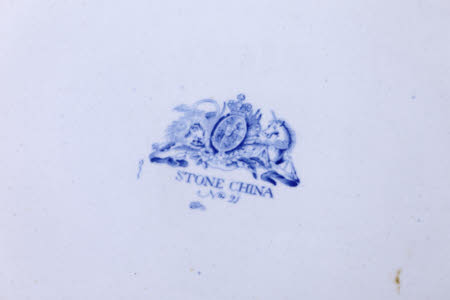Tureen stand
Hicks and Meigh (c.1803-1822)
Category
Ceramics
Date
1815 - 1822
Materials
ironstone china transfer printed in underglaze blue
Measurements
270 mm (Width); 390 mm (Length)
Place of origin
Stoke-on-Trent
Order this imageCollection
Hill Top, Cumbria
NT 641463
Summary
Tureen stand, ironstone china, oval form with a raised well, gadrooned edge and twisted upright handles, made by Hicks & Meigh, Stoke on Trent, ca 1815-22; transfer printed in blue with pattern number 21, with a chinoiserie style stylised garden scene with zig-zag fences and groups of flowers, dentil border to the inside of the rim.
Full description
This stand for a soup tureen is from the collection at Hill Top. Beatrix Potter purchased this farmhouse in the Lake District village of Near Sawrey in 1905, using the profits from her books. After her marriage to William Heelis in 1913, Beatrix relocated permanently to Sawrey. The couple made nearby Castle Cottage their home, but Beatrix spent as much time as she could at Hill Top. As well as a space for work and creativity – and the location for many of her famous tales – it became an intensely personal sanctuary for Beatrix. Beatrix knew exactly how she would decorate Hill Top and she arranged its interiors carefully and deliberately. She wrote: ‘I would have old furniture…it is not as expensive as modern furniture, and incomparably handsomer…’ Once she had renovated the farmhouse, she filled it with examples of local furniture and treasured heirlooms, like her grandmother’s warming pan and a set of plates decorated with designs by her father. A photograph taken by her father, Rupert Potter, in September 1912 shows Beatrix’s display of blue and white ceramics on the hall dresser (HIL.R.345) – including this stand. Most of these can be identified in the collection today, though some are now displayed in other rooms. They are a mixture of Staffordshire transfer printed earthenware and Chinese porcelain, with a splash of colour offered by a Chinese export bowl. The 1946 inventory of Hill Top, made after Beatrix’s death and following its preparation for the visiting public, suggests that the display had stayed largely the same, at least in aesthetic terms, though four of the plates decorated by her father were by that time also displayed on the dresser. This stand was made by the firm Hicks & Meigh, which operated between c. 1803-22 at the High Street Works in Shelton, Stoke on Trent. Hicks & Meigh produced high quality dinner, dessert and tea services. From about 1813, they were one of the leading makers of ironstone china – a strong and durable type of ceramic first introduced as an alternative to imported Chinese porcelain. The stand is printed in an underglaze blue transfer printed pattern influenced by Chinese export patterns and designed to incorporate different shades of blue.
Marks and inscriptions
Stone China, No. 21 (marked and with royal arms)
Makers and roles
Hicks and Meigh (c.1803-1822), manufacturer

